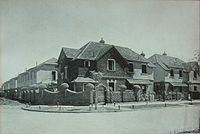1920 Argentine legislative election
| ||||||||||||||||||||||||||
101 of 158 seats in theNational Congress | ||||||||||||||||||||||||||
| Turnout | 53.74% | |||||||||||||||||||||||||
|---|---|---|---|---|---|---|---|---|---|---|---|---|---|---|---|---|---|---|---|---|---|---|---|---|---|---|
This lists parties that won seats. See the complete results below.
| ||||||||||||||||||||||||||
TheArgentine legislative elections of 1920were held on 7 March. Voters chose their legislators and numerous governors, and with a turnout of 53.7%.
Background
[edit]

A strong economy and a vigorous social policy helped make 1920 a banner year for PresidentHipólito Yrigoyen,whose UCR won 61 of the 102 seats at stake in the Lower House of Congress.[1]
The party emerged victorious in theCity of Buenos Aires,Entre Ríos,La Rioja,Santiago del Estero,and even in districts which had hitherto been dominated by either opposition parties (such asBuenos Aires ProvinceandTucumán), or dissident factions of the UCR (as in the case ofSanta Fe).[1]The party effectively displaced both the Socialist and Democratic Progressive parties in the highly competitive Buenos Aires district by supporting labor rights and advancing programs such as the National Inexpensive Housing Commission (CNCB), which added thousands of units to the capital's perennially strained housing supply.[2]The addition of 38 seats to the Chamber of Deputies, partly as a result of the 1914 Census, further enhanced the UCR's sweep, and for the first time, gave them an absolute majority in the Lower House.
Socialists made modest gains in Congress, and won control of local governments inZárateandMar del Plata(the first in Argentina). The Democratic Progressive Party, organized by reformist CongressmanLisandro de la Torrefrom his Southern League in 1914, continued to make gains, and triumphed inCórdoba Province(though not in Santa Fe, de la Torre's home province). They displaced their former allies, the Conservatives (a holdover from the landowner-controlledNational Autonomist Party,which was in power from 1874 to 1916), as the largest party in the minority. Conservatives continued to dominate theSenate,however, and much of Yrigoyen's legislation - notably the establishment of a nationalmerchant marine- continued to encounter long delays. Nor had Yrigoyen been persuasive among the nation's governors, and at the time of the March 1920 elections, fully 14 had been replaced by presidentially-decreed federal intervention.
The removal of Governors by presidential decree had, by itself, helped discourage the establishment of dissident UCR factions, of which there were no fewer than five prior to the election; these elections left onlyMendoza Provincewith a dissident UCR majority delegation. The most prominent such faction, that was led by Santa Fe GovernorRodolfo Lehmannand 8 Congressmen at its height, was weakened by his resignation at the end of 1919, and presented no candidates in 1920. The reformist governor's struggle with theLa Forestalloggingcompany, whose striking workers were brutally repressed by both company heavies and national troops, was more to blame for his departure than were differences with President Yrigoyen, and illustrated the limits of the era of pluralist government that began in 1916.[3][4]
Results
[edit]| Party | Votes | % | Seats won | Total seats | |
|---|---|---|---|---|---|
| Radical Civic Union(UCR) | 338,881 | 47.20 | 62 | 95 | |
| Total Conservative Parties | 128,170 | 17.85 | 15 | 32 | |
| Conservative Party | 71,473 | 9.96 | 10 | — | |
| Liberal Party of Corrientes | 16,453 | 2.29 | 2 | — | |
| Liberal Party of Tucumán | 12,769 | 1.78 | — | — | |
| Provincial Union | 8,092 | 1.13 | 1 | — | |
| Civic Concentration | 7,712 | 1.07 | 2 | — | |
| Democratic Union | 6,120 | 0.85 | — | — | |
| Autonomist Party of Mendoza | 5,551 | 0.77 | — | — | |
| Democratic Progressive Party(PDP) | 116,383 | 16.21 | 14 | 14 | |
| Socialist Party(PS) | 83,959 | 11.69 | 7 | 10 | |
| Total Dissident Radical Civic Union | 32,334 | 4.50 | 3 | 7 | |
| Intransigent Radical Civic Union | 9,450 | 1.32 | — | — | |
| Black Radical Civic Union | 8,671 | 1.21 | 1 | — | |
| Lencinist Radical Civic Union | 7,319 | 1.02 | 1 | — | |
| Officialist Radical Civic Union | 4,109 | 0.57 | 1 | — | |
| Independent Radical Civic Union | 2,785 | 0.39 | — | — | |
| Argentine Socialist Party | 8,726 | 1.22 | — | — | |
| International Socialist Party | 4,427 | 0.62 | — | — | |
| Popular Union | 2,181 | 0.30 | — | — | |
| Feminist Party | 1,258 | 0.18 | — | — | |
| Unitarian Party | 672 | 0.09 | — | — | |
| Agrarian League | 381 | 0.05 | — | — | |
| Others | 585 | 0.08 | — | — | |
| Total | 717,957 | 100 | 101 | 158 | |
| Positive votes | 717,957 | 93.01 | |||
| Blank votes | 19,845 | 2.57 | |||
| Invalid votes | 11 | 0.00 | |||
| Tally sheet differences | 34,100 | 4.42 | |||
| Total votes | 771,913 | 100 | |||
| Registered voters/turnout | 1,436,472 | 53.74 | |||
| Source:[5] | |||||
References
[edit]- ^abNómina de diputados de la nacion por distrito electoral: periodo 1854-1991.Buenos Aires: Cámara de Diputados de la Nación, Secretaría Parlamentaria, Dirección de Archivo, Publicaciones y Museo, Subdirección de Publicaciones e Investigaciones Históricas, 1991.
- ^Todo Argentina: 1920(in Spanish)
- ^Gianello, Leoncio.Historia de Santa Fe.Buenos Aires: Editorial Plus Ultra, 1978.
- ^Rock, David.Argentina: 1516-1982.University of California Press, 1987.
- ^Memoria del Ministerio del Interior presentada al Honorable Congreso de la Nación 1919-1920.Vol. Tomo I. Buenos Aires: Estudio Gráfico de A, de Martino. 1920. p. 22-65.

